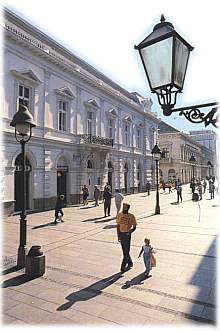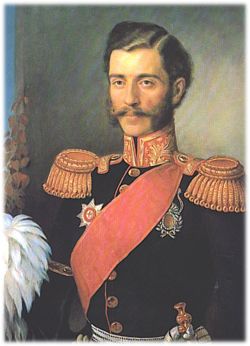
Has been closed to traffic and transformed into a promenade and shopping street, now known
as the korzo of Belgrade. Acquired its present name as long ago as 1872.


 ihailo Obrenović (b. Kragujevac 1823, d. Belgrade 1868), Prince of Serbia, son of Prince
Miloš and Princess Ljubica, came to power for the first time when his brother Milan died in
1839. The Sultan confirmed him as elected but not as hereditary. Prince and, in August
1842, a revolt was organized by Toma Vučić, Mihailo was forced to leave Serbia, and
Aleksandar Karađorđević came to the throne. When Miloš Obrenović returned to Serbia in
1858, Mihailo came with him and took over supreme command of the army. He again became
Prince of Serbia when Miloš died in 1860. In 1861. He made extensive changes in the
constitutional structure of the state: the authority of the Council for Legislative
Affairs was limited and the independence of its members abolished; ministers were
henceforth to be responsible only to the Prince; freedom of the press was abolished; and
the National Assembly became only an advisory organ. Mihailo paid special attention to
military matters and in 1861 established a national army with about 50,000 soldiers in its
ranks. Up-to-date weaponry was provided, and Serbia became the strongest military power in
the Balkans. Mihailo's aim was nothing less than the final liberation of his country from
the Turks.
Counting on a war with Turkey, he formed alliances and made agreement with other Balkan
nations - Montenegro, Greece, Bulgaria and Romania - and Serbia thus became the centre of
a Balkan alliance against the Turks. But just as he was completing preparations for the
war, Mihailo was assassinated while out walking on Košutnjak in June 1868.
ihailo Obrenović (b. Kragujevac 1823, d. Belgrade 1868), Prince of Serbia, son of Prince
Miloš and Princess Ljubica, came to power for the first time when his brother Milan died in
1839. The Sultan confirmed him as elected but not as hereditary. Prince and, in August
1842, a revolt was organized by Toma Vučić, Mihailo was forced to leave Serbia, and
Aleksandar Karađorđević came to the throne. When Miloš Obrenović returned to Serbia in
1858, Mihailo came with him and took over supreme command of the army. He again became
Prince of Serbia when Miloš died in 1860. In 1861. He made extensive changes in the
constitutional structure of the state: the authority of the Council for Legislative
Affairs was limited and the independence of its members abolished; ministers were
henceforth to be responsible only to the Prince; freedom of the press was abolished; and
the National Assembly became only an advisory organ. Mihailo paid special attention to
military matters and in 1861 established a national army with about 50,000 soldiers in its
ranks. Up-to-date weaponry was provided, and Serbia became the strongest military power in
the Balkans. Mihailo's aim was nothing less than the final liberation of his country from
the Turks.
Counting on a war with Turkey, he formed alliances and made agreement with other Balkan
nations - Montenegro, Greece, Bulgaria and Romania - and Serbia thus became the centre of
a Balkan alliance against the Turks. But just as he was completing preparations for the
war, Mihailo was assassinated while out walking on Košutnjak in June 1868.



Albania Palace Building |
The Bajrakli Mosque |
Belgrade Palace Building |
Belgrade Railway Station |
Captain Miša's Building |
Cvijeta Zuzorić Art Pavilion |
Karađorđeva Street |
Knez Mihailova Street |
Princess Ljubica's Residence |
Millenary Monunemt on Gardoš Hill |
Price Miloš's Residence |
The National Theatre |
Nemanjina Street |
Nikola Pašic Square |
Republic Square |
Skadarlija |
Slavija Square |
Student Square |
The Trade Union Hall |
Terazije Square |
The '?' Cafe Restaurant |
Article about the architecture and building in Belgrade
|




